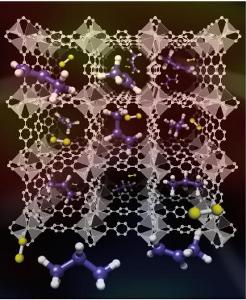UCLA chemists for the first time have employed magnetic resonance imaging (MRI) — a technique normally reserved for medical clinicians peering inside the human body — to better measure the temperature of gases inside a catalytic reactor.
 A continuous-flow micro-reactor packed with metal-organic framework catalyst promotes the conversion of propylene into propane. UCLA researchers measured the heat generated in the reaction without perturbing the flow by using an MRI technique. (credit: UCLA/Nanette Jarenwattananon, Yuebiao Zhang, Louis Bouchard)
A continuous-flow micro-reactor packed with metal-organic framework catalyst promotes the conversion of propylene into propane. UCLA researchers measured the heat generated in the reaction without perturbing the flow by using an MRI technique. (credit: UCLA/Nanette Jarenwattananon, Yuebiao Zhang, Louis Bouchard)
The research, a major step toward bridging the gap between laboratory studies and industrial catalysis, could help improve the design and environmental impact of catalytic reactors, including tiny "lab-on-a-chip" devices, which are used in the manufacture of pharmaceuticals and other chemical products.
Reporting Oct. 24 in the journal Nature, the researchers from UCLA's College of Letters and Science, describe their new method for mapping the temperatures at the gas–solid interface, in which gases are altered through contact with a solid catalyst.
Measuring temperature distributions within a reactor is crucial to understanding the energetics of a chemical reaction as reacting gases flow over a catalyst and to optimizing reactor design. But until recently, it was not possible to probe gas temperatures in the reaction mixture without at the same time perturbing the flow inside an operating reactor.
"The new method is important because an overwhelming majority of chemical industry products are made using heterogeneous catalysts functioning at the gas–solid interface," said the study's senior author, Louis Bouchard, an assistant professor of chemistry and biochemistry and a member of UCLA's California NanoSystems Institute.
Under the leadership of Bouchard, recipient of a 2012 Beckman Young Investigator Award, UCLA chemistry graduate student researcher Nanette Jarenwattananon and her colleagues applied magnetic-field gradients — which are normally used to generate density images in MRI — across a catalytic reactor as a means to spatially encode the temperature of the gas. Warmer molecules move faster, leading to longer-lived magnetic resonance signals, while signals from colder molecules decay more rapidly.
"While there are methods to probe temperatures in liquids, few approaches exist for mapping the properties of gases inside a catalytic reactor without perturbing the flow being studied," Bouchard said. "The inherent non-invasive nature of MRI bypasses this issue and allows us to generate thermal maps of gases during the course of a reaction."
The researchers also demonstrated microscale MRI images in a micro-reactor using parahydrogen, a state of the hydrogen molecule in which the nuclei are aligned in opposite directions. During the chemical reaction they studied — the hydrogenation of propylene to propane — parahydrogen is part of the propane molecule and is converted into observable nuclear magnetism to enhance the MRI signal.
"The ability to follow the reaction in a micro-reactor will help engineers and chemists design better lab-on-a-chip devices," Bouchard said, which are increasingly used in pharmaceutical synthesis and industrial catalytic reactions.
Catalytic micro-reactors may provide green chemistry alternatives — less chemical waste, lower cost and minimal energy waste — to conventional, industrial-sized reactors because they make it easier to control the chemical-reaction conditions and operate the reactor closer to optimal conditions. However, a longstanding problem has been the lack of tools to map out the chemical reaction conditions inside micro-reactors. Bouchard and his co-workers have now demonstrated non-invasive maps of gas temperatures inside micro-reactors with the assistance of MRI.
The research, which is federally funded by the National Science Foundation, was carried out in collaboration with Omar M. Yaghi, UC Berkeley's James and Neeltje Tretter Professor of Chemistry, in order to demonstrate the methodology on new, emerging catalysts based on metal organic frameworks, which are projected to be ideal platforms for lab-on-a-chip catalysis at the microscale.
Other co-authors on the paper include Stefan Glöggler, Trenton Otto, Arek Melkonian, William Morris and Scott R. Burt (Brigham Young University). Otto and Melkonian are recipients of Senior Undergraduate Research Scholar awards from UCLA's Undergraduate Research Scholars Program.
Bouchard's laboratory has been developing novel methodology and instrumentation for visualizing chemical reaction processes and thermodynamics in real time.